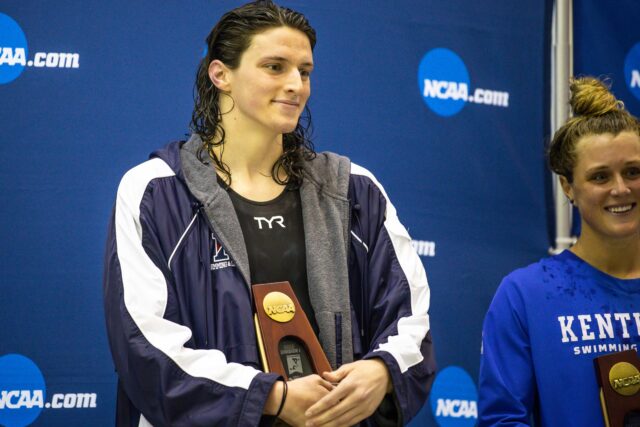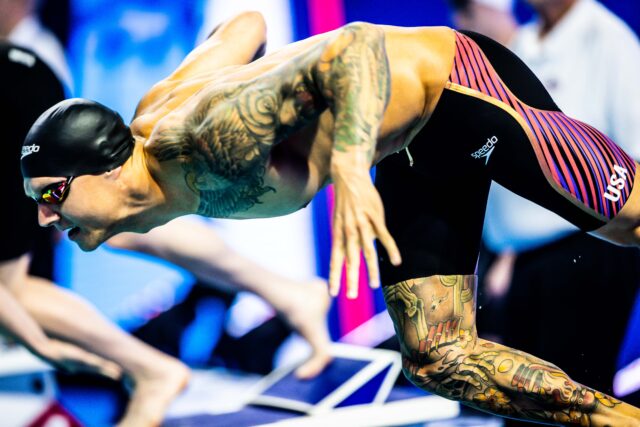By James Sutherland on SwimSwam

A recent study financed by the International Olympic Committee (IOC) has brought forward a new data set to the ongoing and often hotly debated discussion about trans women and their place in elite sports.
The research showed that transgender female athletes had greater handgrip strength—an indicator of overall muscle strength—but lower jumping ability, lung function and relative cardiovascular fitness compared to cisgender women.
The data contradicts the general sentiment that transgender female athletes have a distinct, irreversible advantage over cisgender women which has led to numerous sports federations barring them from competing in women’s sports.
The study was conducted at the University of Brighton (UK) and published this month in the British Journal of Sports Medicine. It tested 19 cisgender men and 12 trans men, along with 23 trans women and 21 cisgender women, all of whom either played sports competitively or underwent physical training at least three times per week. All of the female athletes had undergone at least one year of testosterone suppression and estrogen supplementation.
The findings included:
- Transgender female athletes showed greater handgrip strength compared to cisgender females
- Transgender female athletes had lower lung function and relative VO2 to cisgender females
- Transgender female athletes scored lower than cisgender females and men on a jumping test that measured lower-body power
The study acknowledged its limitations, including a small sample size and not following the athletes over the long term while they transitioned.
One of the study’s authors, Yannis Pitsiladis, told The New York Times that the most important finding was that given physiological differences, “Trans women are not biological men.”
Although the study showed trans female athletes had greater handgrip strength, Dr. Pitsiladis said it is a combination of factors that determined athletic performance.
Athletes who grow taller and heavier after going through male puberty must “carry this big skeleton with a smaller engine” after transitioning, said Dr. Pitsiladis, who is also a member of the IOC’s medical and scientific commission.
Citing volleyball as an example, Dr. Pitsiladis said that for trans female athletes, “the jumping and blocking will not be to the same height as they were doing before. And they may find that, overall, their performance is less good.”
However, Mayo Clinic Doctor Michael J. Joyner, who studies the physiology of female and male athletes, said that the science supports the various bans on trans female athletes from competing in women’s sports.
“We know testosterone is performance enhancing,” Dr. Joyner said, according to The New York Times. “And we know testosterone has residual effects.”
Dr. Joyner added that declines in performance by trans women after taking hormone-suppressing drugs don’t fully recplicate the typical differences in athletic performance between men and women.
According to the Movement Advancement Project, 25 U.S. states have laws or regulations barring transgender athletes from competing in girls and women’s sports, while some of the sports that will have the most eyes on them at this summer’s Olympics, including swimming, have effectively barred transgender female athletes from competing in the female category.
The IOC, which financed the study but had no input or influence on the results, left eligibility rules for trans women’s participation up to global sports federations.
World Aquatics published its criteria for competing in men’s and women’s divisions in March 2023 and declared intentions to create a new ‘open’ category for trans athletes, which debuted at the Berlin World Cup last year and had no entries.
World Athletics president Sebastian Coe acknowledged that the science surrounding trans athletes is unresolved, but the global governing body barred transgender female athletes, with Coe saying he wasn’t “going to take a risk on this.”
On April 8, the National Association of Intercollegiate Athletics (NAIA) announced a new policy banning trans women from competing in women’s sports.
Arguably the most prominent case of trans women in sports is former Penn swimmer Lia Thomas, a trans woman who won the 2022 NCAA title in the women’s 500 freestyle. ‘
Thomas is challenging World Aquatics current sanction on trans women, while just last month, a group of 16 current and former female athletes, including multiple who competed against Thomas, sued the NCAA over its transgender policy.
Dr. Pitsiladis said he and his researchers have received threats since publishing the study. And with that reality and the political nature of the topic, it will likely lead other scientists to turn away from pursuing the topic further.
“Why would any scientist do this if you’re going to get totally slammed and character-assassinated?” he said, according to The New York Times. “This is no longer a science matter. Unfortunately, it’s become a political matter.”
SwimSwam: IOC-Funded Study Shows Trans Women At Physical Disadvantage In Certain Athletic Areas


















You must be logged in to post a comment Login